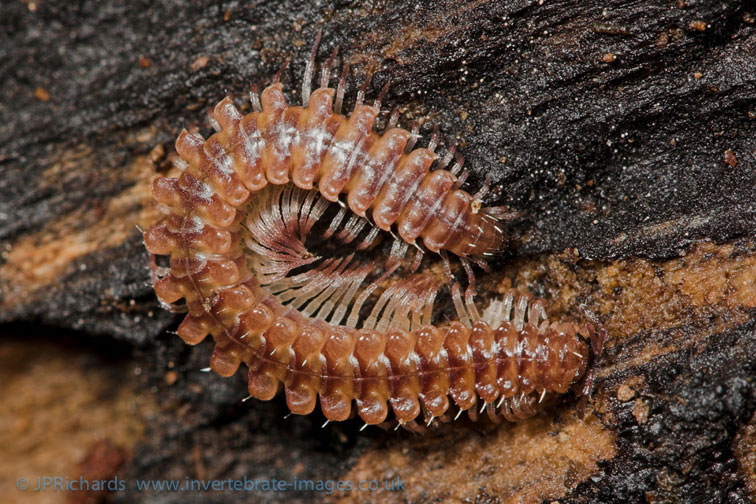Nanogona polydesmoides (Leach, 1814)
Common name
Synonyms
Status:
GB IUCN status: Least Concern
ID Difficulty
Identification
This large species with well developed paranota is easily confused with a Polydesmus flat-back millipede. However, readily identified by having conspicuous eyes comprising numerous well-pigmented ommatidia (Polydesmus sp. completely lack eyes) and 30 body rings when adult (20 rings in adult Polydesmus sp.).
Distribution
This species is common and widespread throughout Britain and Ireland.
Kime (2004) describes its continental distribution as strictly Atlantic. Outside of Britain and Ireland it occurs mainly in France but is very local in Belgium, there is a single record from the west coast of Norway and an outlier population apparently belonging to this species is found in northern Italy.
Habitat
Blower (1985) noted it was the commonest millipede recorded from British caves, a habitat more typical in the south of its European range (Kime, 2001). Analysis of the habitat data confirms a strong association with caves and also with waste ground, especially in urban areas. However, it is found in a wide range of other habitats and has usually been considered a species of deciduous woodlands. Analysis of the environmental data shows, at most, a slight preference for calcareous soils but various authors have noted such a preference (Blower, 1985; Gregory & Campbell, 1996; Kime, 1978). Gordon Corbet (pers. comm.) reports the species as rare in non-calcareous natural sites in Scotland but frequent where there is concrete or mortar. Due to the strong association of the millipede with urban waste ground, these latter records may be masking any association with calcareous soils.
Phenology
Adults have been found throughout the year but are most frequently recorded in the autumn and winter months. Although some individuals may survive for longer, Blower (1985) considered the species to be annual with egg-laying taking place from November to January.
This species account is based on Lee (2006).
References
Blower, J.G. 1985. Millipedes. Synopses of the British Fauna (New Series), No. 35. London: Linnean Society.
Gregory, S.J. & Campbell, J.M. 1996. An Atlas of Oxfordshire Myriapoda: Diplopoda and Chilopoda. Oxfordshire Museums Occasional Paper No. 19.
Kime, R.D. 2004. The Belgian Millipede Fauna (Diplopoda). Bulletin de l’Institut royal des Sciences Naturelles de Belgique, Entomologie, 74, 35-68.
Kime, R.D. 2001. The continental distribution of British and Irish millipedes, part 2. Bulletin of the British Myriapod and Isopod Group, 17, 7-42.
Kime, R.D. 1978. The Distribution of Millipedes in the South of England - A Preliminary Survey. Abhandlungen und Verhandlungen des Naturwissenschaftlichen Vereins in Hamburg, 21/22, 135-147.
Links
MilliBase - Global catalogue of Millipedes: https://millibase.org/aphia.php?p=taxdetails&id=944803













